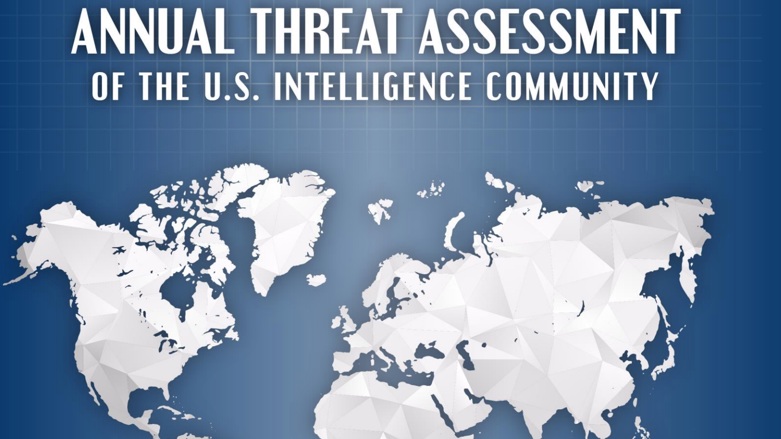U.S. intelligence report depicts Iran as significant threat

WASHINGTON DC, United States (Kurdistan 24) – Earlier this week, the U.S. Intelligence Community issued its annual global threat assessment—a summary and overview of the dangers that the U.S. faces around the world.
The report identified major threats from just four countries. The other threats are, according to the report, transnational threats, such as health, security, terrorism.
Iran was among the four countries identified as significant threats, the three others being Russia, China, and North Korea. That Iran ranks among those countries underscores how seriously the US intelligence community views the danger Iran poses.
The report suggested that differences between the US and Iran were irreconcilable, because “the Iranian regime sees itself as locked in an existential struggle with the United States and its regional allies.” In addition, Iran pursues “longstanding ambitions for regional leadership,” in direct conflict with the U.S.
At that same time, a new vulnerability has emerged for the Iranian regime: the protests, ongoing since last September, when Zhina (Mahsa) Amini, died in the custody of Tehran’s so-called “morality police.”
Just a few days ago, on Wednesday, the State Department inaugurated the Madeleine K. Albright group award for women of courage and accorded it to the “women and girl protestors of Iran.”
In announcing the award, the State Department explained that the “brutal killing” of the young Kurdish woman had “touched a nerve in Iranian society, galvanizing a protest movement.”
Read More US honors ‘Women and Girl Protestors of Iran’ in Madeleine Albright Award
In its global threat assessment, the intelligence community observed that the protests were among Iran’s “most widespread and prolonged protests since the 1979 revolution,” which established the Islamic Republic.
The report also suggested that domestic problems in Iran are likely to increase. “Compounding crises in the coming year will probably further challenge the regime’s legitimacy and staying power,” it stated. “With Iran’s depreciating currency and annual inflation rates of nearly 50 percent in late 2022, Tehran probably faces an economic downturn that the [Intelligence Community] assesses could prolong or reignite unrest and result in greater instability.”
Iranian Threat to the U.S. and its Allies
The report noted several ways in which Iran threatens Americans, “directly and via proxy attacks.” That includes a threat to Americans in their own country, as Iran “remains committed to developing surrogate networks inside the United States, an objective it has pursued for more than a decade.”
Tehran wants revenge for the killing of Qasim Soleimani, head of the Qods Force of Iran’s Islamic Revolutionary Guard Corps (IRGC), in January 2020, in a U.S. drone strike outside the Baghdad airport.
Such efforts on Tehran’s part have already begun. Last August, the U.S. Department of Justice charged an IRGC member with plotting to kill Amb. John Bolton, National Security Council Advisor under former :President Donald Trump. It also appeared that Tehran had developed a second plot to murder Mike Pompeo, Secretary of State under Trump.
Read More: Iran plotted to assassinate Bolton, Pompeo
Moreover, such Iranian plots inside the U.S. are not limited to targeting senior officials. Two such plots, tied to Iran, have targeted private citizens who have been strongly critical of the regime.
Last summer, a young Shia extremist, a 24-year old from New Jersey, stabbed a 75-year old novelist, Salman Rushdie, as he spoke at a cultural event in rural, upstate New York.
Read More: Shi’a Extremist behind assault on Salman Rushdie
Rushdie survived the assault, but lost his sight in one eye and the use of one hand.
Iran also sought to murder an Iranian-American journalist, Masih Alinejad, who lives in New York and works for the Voice of America. In this case, the Iranian regime sought to hide its hand by working through an Azeri criminal gang.
Read More: US: Iran behind Azeri criminal gang that plotted assassination of dissident in New York
The intelligence report also described various ways in which Tehran posed a threat in the Middle East.
“Iran will remain a source of instability across the region, with its backing of Iraqi Shia militias, which pose the primary threat to U.S. personnel in Iraq,” it said.
The report also cited “Iran’s economic and military backing for the regime of Bashar al-Asad in Syria and support to the Houthis in Yemen,” which threatens Saudi Arabia in particular.
Hybrid Warfare
“Iran’s hybrid approach to warfare—using both conventional and unconventional capabilities—will pose a threat to U.S. interests in the region for the foreseeable future,” the intelligence report said.
“Iran probably will seek to acquire new conventional weapons systems, such as advanced fighter aircraft, trainer aircraft, helicopters, air defense systems, para-naval patrol ships, and main battle tanks,” it stated, providing examples of how Iran is boosting its conventional military capabilities.
Indeed, Iran is expected, quite soon, to receive both advanced fighter jets and an air defense system from Moscow in exchange for having provided Russia with explosive drones and other weapons systems for use in the Ukraine war.
In addition, “Iran’s ballistic missile programs, which already include the largest inventory of ballistic missiles in the region, continue to pose a threat to countries across the Middle East,” the report stated.
At the same time, Iran has a major unconventional warfare capability. Its “network of militant partners and proxies” enables “Tehran to try to advance its interests in the region and maintain strategic depth.”
Nuclear Threat
The report offered a mixed view of Tehran’s nuclear program. It noted that Iran “continues to increase the size and enrichment level of its uranium stockpile” beyond the limits set by the 2015 nuclear deal, formally known as the Joint Comprehensive Plan of Action (JCPOA.)
However, it also noted that “Iran is not currently undertaking the key nuclear weapons-development activities that would be necessary to produce a testable nuclear device.”
